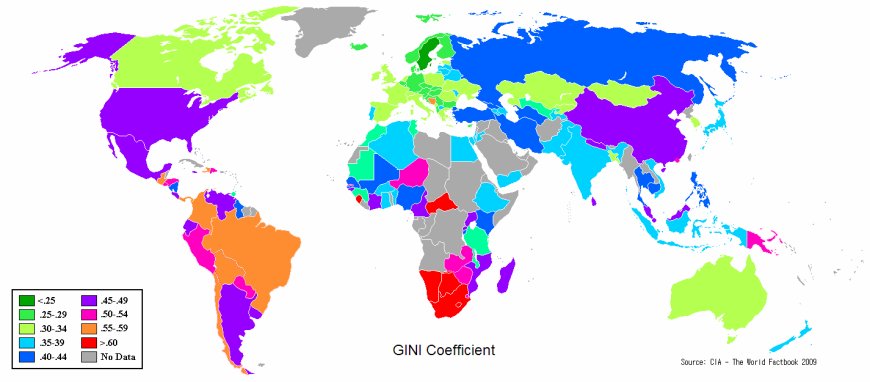Against All Odds: India Ranks 4th Most Equal Country on Global Gini Index, Beating US, UK, and G7 Nations
India ranks 4th most equal country globally on the Gini Index, ahead of the US and UK. Explore how India’s low income inequality reflects broader economic structures and hidden challenges.

By Ronald Kapper
Published: July 7, 2025
Introduction
In a surprising global ranking, India has emerged as the world’s 4th most equal country in terms of income distribution, according to the Gini Index published by the World Bank. With a Gini score of 25.5, India stands ahead of economic giants like the United States, United Kingdom, and most G7 and G20 nations, and is surpassed only by Slovakia, Slovenia, and Belarus.
The Gini Index, a globally accepted measure of income inequality, ranges from 0 (perfect equality) to 100 (complete inequality). A lower score denotes a more equal income distribution. India’s performance challenges long-standing narratives around wealth concentration and extreme poverty, prompting a closer look at what the numbers really mean — and what they might be masking.
This article explores the data behind the ranking, why India appears more equal than most Western economies, and the deeper social and economic forces at play.
What Is the Gini Index and Why Does It Matter?
The Gini Index, developed by Italian statistician Corrado Gini, is widely used by international institutions including the World Bank and United Nations Development Programme (UNDP) to evaluate economic inequality. It reflects how evenly income or wealth is distributed among a country's population.
📌 India’s Gini score: 25.5
📌 Rank: 4th most equal globally (as per latest World Bank data)
📌 Ranked better than: Canada (33.3), UK (36.6), USA (41.1), Germany (31.9), China (38.5)
You can view the latest dataset here:
👉 World Bank Gini Index Data
Why Is India Ranking So Equal?
At first glance, this ranking might seem counterintuitive. India is still home to millions living below the poverty line, and stories of billionaire wealth, like that of the Ambani and Adani families, dominate headlines.
So how is India scoring better than the US or UK?
1. Low Formal Incomes Across the Board
The primary explanation is that India’s income levels are generally low across a wide base. With a large informal sector and relatively compressed wage structures, income differences may be narrower — though this doesn’t necessarily mean better living standards.
2. Massive Informal Economy
Over 90% of India’s workforce is employed in the informal sector. This has the effect of flattening incomes, as most earn within a modest band. Unlike countries with strong middle and upper classes, India’s working class represents the vast majority.
3. Redistribution via Subsidies
Schemes like PM-KISAN, free ration distribution, MGNREGA, and Jan Dhan Yojana have pushed modest amounts of money into rural households. These transfers, while not large, narrow the income gaps between the poorest and middle-income families.
You can read more about such welfare schemes here:
👉 Economic Survey of India 2024-25 – Ministry of Finance
International Comparisons: How India Beats the West
Let’s look at how India compares with leading economies:
| Country | Gini Index Score | Rank |
|---|---|---|
| Slovakia | 23.2 | 1 |
| Slovenia | 24.2 | 2 |
| Belarus | 25.0 | 3 |
| India | 25.5 | 4 |
| Germany | 31.9 | 25 |
| United Kingdom | 36.6 | 38 |
| United States | 41.1 | 52 |
| China | 38.5 | 43 |
| Brazil | 53.4 | 87 |
| South Africa | 63.0 | 92 |
Data Source: World Bank Gini Index 2025
The United States, for example, is a highly developed country with high per capita income. Yet it also experiences stark income gaps between its rich and poor, exacerbated by wage polarization, tax policy, and systemic inequality.
The Reality Behind the Numbers
While India may have a low Gini score, that doesn’t automatically translate to economic prosperity or fairness. In fact, low inequality in a low-income economy often means that most people are equally poor.
What the Gini Index Doesn’t Capture:
-
Wealth inequality (as opposed to income)
-
Urban-rural development gaps
-
Access to quality education, healthcare, and infrastructure
-
Caste-based and gender disparities
In fact, Oxfam India’s 2023 report found that the top 1% of India’s population holds over 40% of national wealth, suggesting a disproportionate concentration of assets.
Read the full Oxfam report here:
👉 Oxfam India – Inequality Kills Report
Public Reaction: A Mixed Response
The news of India’s Gini ranking sparked wide debate across social media. Some celebrated the finding as evidence of strong welfare distribution, while others called it “statistical camouflage” hiding poverty under the veil of equality.
Noted economist Jean Drèze remarked:
“The low Gini score reflects compressed incomes rather than inclusive prosperity. The focus should remain on raising incomes for the bottom 50%, not just narrowing the gap.”
What's Next: Can India Maintain This Equality?
While the score may be encouraging in some ways, it comes with an urgent responsibility to use this “equality” as a foundation for upward mobility — not complacency.
Policy Recommendations:
-
Increase direct income support for low-income families.
-
Strengthen universal public services like healthcare and education.
-
Empower women and marginalized communities with equitable access to jobs and finance.
-
Boost formal sector employment to ensure long-term income growth.
-
Tax the ultra-wealthy fairly to reduce hidden wealth inequality.
Final Thoughts
India’s ranking as the 4th most equal country on the Gini Index should be viewed as a moment for introspection, not self-congratulation. True equality isn’t just about having similar incomes — it’s about giving every citizen equal opportunity, dignity, and access to quality life.
If used strategically, this equality baseline can become a launchpad for real economic transformation, where the country doesn’t just close the income gap, but raises the floor for all.














